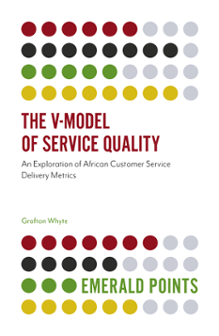
References
The V-Model of Service Quality
ISBN: 978-1-78769-606-8, eISBN: 978-1-78769-603-7
Publication date: 18 October 2018
Citation
Whyte, G. (2018), "References", The V-Model of Service Quality, Emerald Publishing Limited, Leeds, pp. 113-115. https://doi.org/10.1108/978-1-78769-603-720181011
Publisher
:Emerald Publishing Limited
Copyright © 2018 Emerald Publishing Limited
Abdullah (2006) Abdullah, F. (2006). Measuring service quality in higher education: HEdPERF versus SERVPERF. Marketing Intelligence & Planning, 24(1), 31–47. doi:10.1108/02634500610641543
Al-allak & Bekhet (2011) Al-allak, B. A. , & Bekhet, H. A. (2011). Beyond SERVQUAL: A paradigm shift. Australian Journal of Basic & Applied Sciences, 5(7), 129–134.
Augustyn & Seakhoa-king (2004) Augustyn, M. M. , & Seakhoa-king, A. (2004). Is the SERVQUAL scale an adequate measure of quality in leisure, tourism and hospitality? Advances in Hospitality & Leisure, 1(4), 3–24. doi:10.1016/S1745-3542(04)01001-X
Bytheway (2015) Bytheway, A. (2015). Investing in information: The information management body of knowledge. Springer International PU.
Carr (2007) Carr, C. L. (2007). The FAIRSERV model: Consumer reactions to services based on a multidimensional evaluation of service fairness. Decision Sciences, 38(1), 107–130.
Gilmore & McMullan (2009) Gilmore, A. , & McMullan, R. (2009). Scales in services marketing research: A critique and way forward. European Journal of Marketing, 43(5/6), 640–651. Retrieved from http://www.emeraldinsight.com/doi/pdfplus/10.1108/03090560910946972
Johnson & Mathews (1997) Johnson, C. , & Mathews, B. P. (1997). The influence of experience on service expectations. International Journal of Service Industry Management, 8(4), 290–305. doi:10.1108/09564239710174381
Kelly (1955) Kelly, G. A. (1955). The psychology of personal constructs (pts 1 & 2). New York, NY: Norton.
Ladhari (2009) Ladhari, R. (2009). A review of twenty years of SERVQUAL research. International Journal of Quality & Service Sciences, 1(2), 172–198. doi:10.1108/17566690910971445
Mandler, Mussen, & Kogan (1967) Mandler, G. , Mussen, P. , & Kogan, N. (1967). New directions in psychology: III. Oxford: Holt, Rinehart, and Winston. Retrieved from http://psycnet.apa.org/psycinfo/1967-11115-000
Miller (1956) Miller, G. A. (1956). The magical number seven, plus or minus two: Some limits on our capacity for processing information. Psychological Review, 53, 81–97.
Parasuraman, Zeithaml, & Berry (1985) Parasuraman, A. , Zeithaml, V. A. , & Berry, L. L. (1985). A conceptual model of service quality and its implications for future. Journal of Marketing, 49(4), 41–50.
Smith (1986) Smith, M. (1986). An introduction to repertory grids – Part one. Graduate Management Research, 3(1), 4–17.
Tan & Hunter (2002) Tan, F. B. , & Hunter, M. G. (2002). The repertory grid technique: A method for the study of cognition in information systems. MIS Quarterly, 26(1), 39–57.
Tate & Evermann (2010) Tate, M. , & Evermann, J. (2010). The end of SERVQUAL in online services research: Where to from here? E-Service Journal, 7(1), 60–85.
Taylor & Cronin (1994) Taylor, S. A. , & Cronin, J. J. Jr. (1994). An empirical assessment of the SERVPERF scale. Journal of Marketing Theory and Practice, 2(4), 52–69.
Vyakarnam (1989) Vyakarnam, S. (1989). Introduction to personal construct theory for application in management. Graduate Management Research, Summer.
Whyte (1995) Whyte, G. . (1995). Understanding user perceptions of successful informations systems. Unpublished PhD dissertation. Cranfield University.
Zeithaml, Parasuraman, & Malhotra (2002) Zeithaml, V. , Parasuraman, A. , & Malhotra, A. (2002). Service quality delivery through web sites: A critical review of extant knowledge. Journal of the Academy of Marketing Science, 30(4), 362–375.
- Prelims
- Chapter 1 Introduction
- Chapter 2 Overview of the VMSQ
- Chapter 3 Identifying Service Attributes (Stage 1)
- Chapter 4 VMSQ – Data Collection (Stage 2)
- Chapter 5 VMSQ – Data Analysis (Stage 3)
- Chapter 6 VMSQ – Reporting (Stage 4)
- Chapter 7 Case Studies
- Chapter 8 A Framework for Customer Service Delivery (CSD)
- Chapter 9 A Road Map for Busy Managers
- References
- Appendix 1
- Appendix 2
- Index